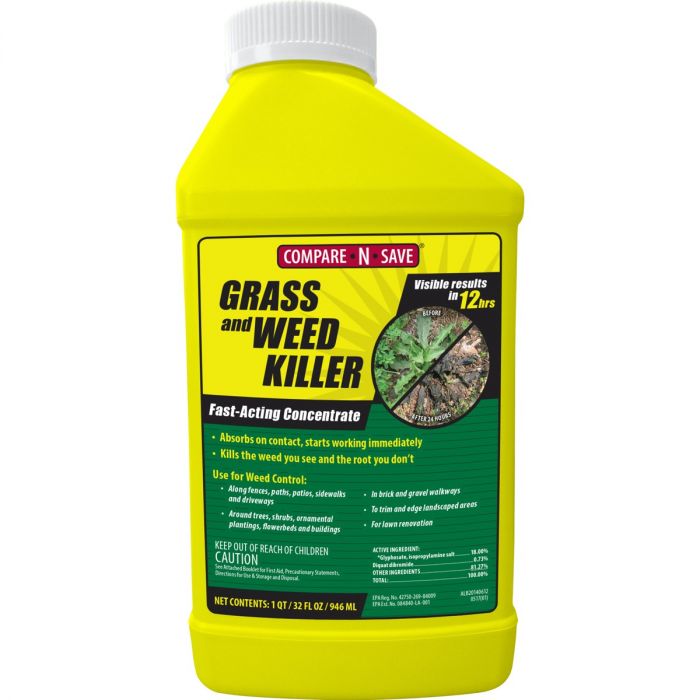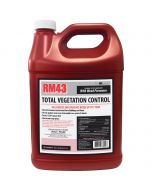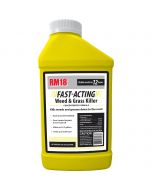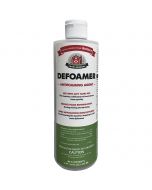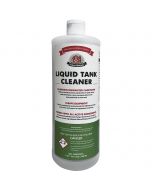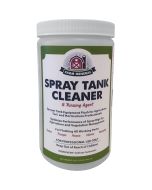Quick Acting Weed and Grass Killer
Grow forth and prosper.
Compare-N-Save Quick Acting Weed & Grass Killer eliminates unwanted weeds and grass that stand between you and your perfect lawn, driveway, and fence line. It enters the plant on contact, producing visible results within hours, and allowing replanting of desired plants within one to three days. For a full list of targeted species, spraying instructions, and replanting recommendations, please see the complete label.
A combination of two herbicides, Compare-N-Save Quick Acting Weed & Grass Killer kills even toughest kudzu, wild blackberry, poison ivy, poison oak, crabgrass, and dandelions (and well over 100 other plants). Spray is rainfast in thirty minutes, safe for pets and people after it is dried and effective for up to 6 months.
Where to use:
| Along fences | Roadsides | For establishment of gardens |
| Patios | Around farm buildings and barns | Walkways |
| Agricultural uncultivated areas | Driveways | Farmyards |
| Parking areas | To prep flower and garden beds** | Mulch beds |
| Lawn replacement | Gravel paths | Vacant lots |
| For establishment and maintenance of wildlife openings. |
** Compare-N-Save Quick Acting Weed & Grass Killer is effective at clearing areas for flower beds and gardens. However, to prevent damage, it SHOULD NOT BE USED for spot weed treatment after planting fruits and vegetables. Hand-pulling is recommended for garden weeds.
When to use:
For best results, apply in early summer during warm, sunny weather when plants are small, but actively growing.
Brush and vines should be cut down to at least four feet tall and sprayed at least four weeks before the first killing frost in the fall.
Re-treatment every 6 to 8 months may be necessary in areas of heavy rainfall. Rainfall or watering after 30 minutes of application will NOT wash away its effectiveness, but applying during sunny, clear weather can accelerate success.
How to use:
For General Vegetation Control
Unless otherwise noted, mix 6 fl. oz. of product per gallon of water to produce 1 to 10 gallons of spray solution to cover 1,000 square feet. Use hand-operated spray equipment such as backpack sprayers, pump-up sprayers or sprinkling cans, or ATV/tractor-mounted sprayers. Uniformly spray the mix over areas where total vegetation control is desired. Maximum application rate of this product is 2.5 gallons per acre per year (6 fl. oz. per 1,000 sq. ft. per year).
A ratio of 3 fl. oz (6 TBS) to 1 gallon of water can be used for easy-to-kill weeds, like seedlings and small soft plants.
For Spot Control of Brush, Vines, and Weeds
Thoroughly and uniformly spray foliage of woody plants to cover all leaves thoroughly. For optimum performance:
- Mix 6 fluid ounces (12 tablespoons or ¾ cup) per gallon of water for every 300 square feet (not to exceed three applications at that rate per year).
- If woody vines and brush are mowed or cut, wait until full leaf formation before treatment.
- Woody vines and brush are better controlled in late summer and fall after fruit formation, at least four weeks before first killing frost.
- Do not cut or mow brush, vines or perennial weeds for two months following treatment to allow for the herbicide to be distributed throughout the plant.
- Dead poisonous plants like poison oak and poison ivy can still cause allergic reactions. Dispose of plants with rubber gloves and place in tightly sealed garbage bags.
- Additional treatments may be necessary for exceptionally hardy plants.
For Lawn Replacement or Patio Preparation
To clear a large area of unwanted lawn and weeds, mix 6 fluid ounces per gallon of water for every 300 square feet. Do not to exceed three applications at that rate per year.
- Do not mow prior to spraying. Leave grass up to 6 inches long to increase available surface area for spray contact.
- If replanting right away, soak soil and allow grass and plant leaves to dry before application, and then water area two or three days after application to deactivate unpenetrated spray.
- Retreat areas that remain green after seven days.
- Wait three days after application before raking, tiling, sodding, or seeding.
For Flowerbed and Garden Prep
For best results, soak soil (not leaves) with water before application and three days after spraying. Wait one to three days after last application before planting flowers, trees, and shrubs. Wait three days to plant vegetables, fruits, herbs, and grasses.
Precautions:
- Do not apply this product in a way that will make contact with people or pets, either directly or through drift. Only protected handlers may be in the area during application. For any requirements specific to your state or tribe, consult the agency responsible for pesticide regulation.
- Do not allow entry to treated areas until spray has dried thoroughly.
- Do not use on feed or food crops.
- Protect desirable plants around the spray area with plastic.
Active Ingredients:
| Glyphosate, isopropylamine salt | 18.00% |
| Diquat dibromide | 0.73% |
| Other Ingredients | 81.27% |
| Total | 100.00% |
Product Label:
Disclaimer:
It is a violation of Federal law to use this product in a manner inconsistent with its labeling. Read the entire label before each use. Use only according to label instructions.
See the complete label for specific use rates and detailed instructions.
Consult the Safety Data Sheet (SDS) for important safety information.

